2021 MERCEDES-BENZ GLE belt
[x] Cancel search: beltPage 44 of 490
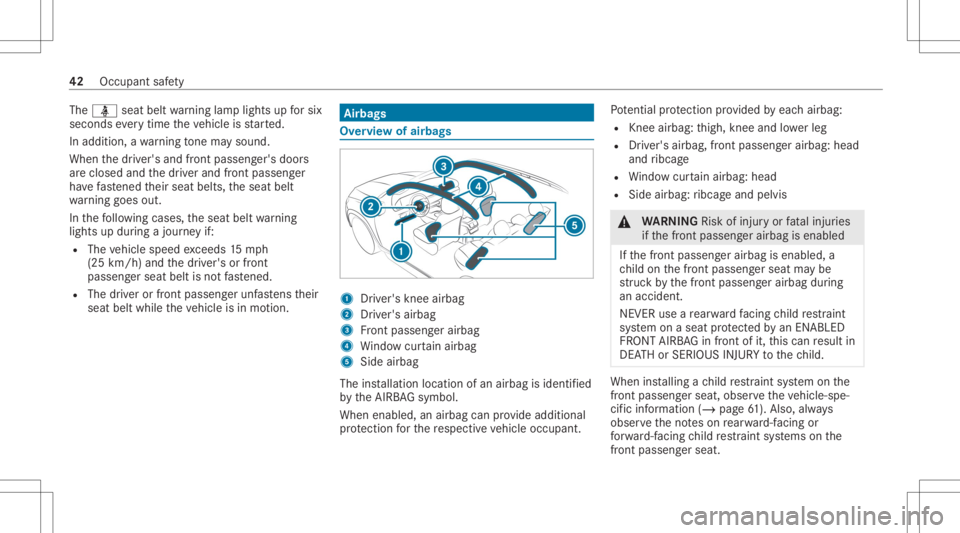
The
00E9 seatbeltwarning lam plight sup forsix
seconds everytim eth eve hicle isstar ted.
In addition, awa rning tone maysou nd.
Whe nth edr iver's andfront passeng er'sdoor s
ar eclosed andthedr iver and front passeng er
ha ve fastened their seat belts, theseat belt
wa rning goes out.
In thefo llo wing cases ,th eseat beltwarning
light sup dur ing ajour neyif:
R The vehicle speed exceeds 15mp h
(25 km/ h)and thedr iver's orfront
passeng erseat beltisno tfa stened.
R The driver or front passeng erunf astens their
seat beltwhile theve hicle isin mo tion. Airbags
Ov
ervie wof airbags 1
Driver's knee airbag
2 Driver's airbag
3 Front passeng erairbag
4 Windo wcur tain airbag
5 Side airbag
The installation locationofan airbag isident ified
by theAIRB AGsymbol.
When enabled, anairbag canprov ide addition al
pr otect ion forth ere spectiv eve hicle occupant. Pot
entialprotect ion prov ided byeac hairbag:
R Knee airbag: thigh, knee and lowe rleg
R Driver's airbag,front pass engerairb ag:head
and ribcag e
R Windo wcur tain airbag: head
R Side airbag: ribcag eand pelvis &
WARNIN GRisk ofinju ryor fata linj uries
if th efront passeng erairbag isenabled
If th efront passeng erairbag isenabled, a
ch ild on thefront passeng erseat maybe
st ru ck bythefront passeng erairbag during
an acciden t.
NEVE Ruse are ar wa rdfacing child restra int
sy stem onaseat protect edbyan ENABLED
FR ONT AIRB AG infront ofit,this can result in
DEA THorSERIOUS INJURYto thech ild. When
installing ach ild restra int system onthe
fr ont passeng ersea t,obse rveth eve hicle-spe‐
cif icinf ormation (/page61 ).Also, always
obser vetheno teson rear wa rd-faci ng or
fo rw ard-f acin gch ild restra int systems onthe
fr ont passeng ersea t. 42
Occupa ntsaf ety
Page 45 of 490
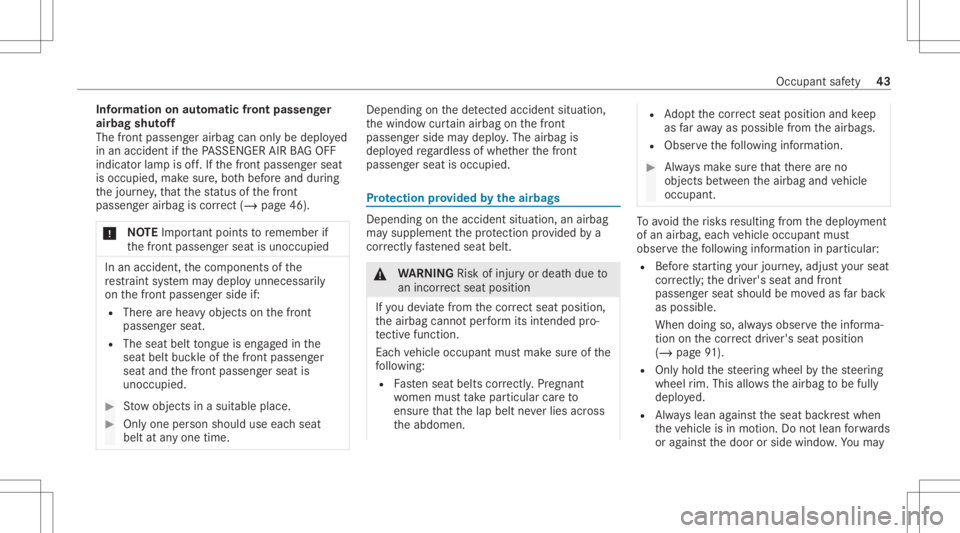
Inf
orma tion onautomatic fron tpass enger
airbag shutoff
The front passeng erairbag canonlybe dep loye d
in an acc ident ifth ePA SSENGER AIRBAGOF F
ind icat orlam pis off.Ifth efront passeng erseat
is occupied, makesur e,bo th bef oreand during
th ejour ney,that thest atus ofthefront
passeng erairbag iscor rect (/ page 46).
* NO
TEImpo rtant poin tsto remember if
th efront passeng erseat isunocc upied In
an acciden t,th ecom ponen tsof the
re stra int system maydeplo yunnec essarily
on thefront passeng erside if:
R Ther ear ehea vyobjec tson thefront
passeng erseat.
R The seat belttongu eis eng aged inthe
seat beltbuckleofthefront passeng er
seat andthefront passeng erseat is
unocc upied. #
Stow object sin asuit able place. #
Onlyone person should useeachseat
belt atanyone time. Depending
onthede tected acci dent situation,
th ewindo wcur tain airbag onthefront
passeng erside maydeplo y.The airbag is
deplo yedre ga rdless ofwhe ther thefront
passeng erseat isoccupied. Pr
otection prov ided bytheair bags Dep
endingontheacciden tsituation ,an airbag
ma ysupplement thepr otect ion prov ided bya
cor rectl yfa stened seatbelt. &
WARNIN GRisk ofinju ryor deat hdue to
an incorrect sea tpos ition
If yo ude viat efrom thecor rect sea tpos ition,
th eairbag cannotper form itsintended pro‐
te ctiv efuncti on.
Eac hve hicle occupant mustmak esur eof the
fo llo wing:
R Fasten seat belts correctl y.Pregnant
wo men mustta ke par ticular careto
ensur eth at thelap belt neverlie sacr oss
th eabdomen. R
Adoptth ecor rect sea tpos ition and keep
as faraw ay as poss iblefrom theairbags.
R Obser vethefo llo wing informatio n. #
Alw aysmak esur eth at ther ear eno
objec tsbetween theairbag andvehicle
occupant. To
avo idtherisk sre sulting from thedeplo yment
of an airbag, eachve hicle occupant must
obser vethefo llo wing informatio nin par ticular :
R Beforest ar tin gyo ur jour ne y,adjus tyo ur seat
co rrect ly;th edr iver's seat andfront
passeng erseat should bemo vedas farbac k
as possi ble.
When doingso,alwaysobser vetheinf orma‐
tion onthecor rect driver's seatpos ition
(/ page 91).
R Onlyho ldthesteer ing wheel bythesteer ing
wheel rim. This allow sth eairbag tobe fully
deplo yed.
R Alw ayslean agains tth eseat backres twhen
th eve hicle isin mo tion. Donotlean forw ards
or agains tth edoor orside windo w.Youma y Oc
cupan tsaf ety 43
Page 48 of 490
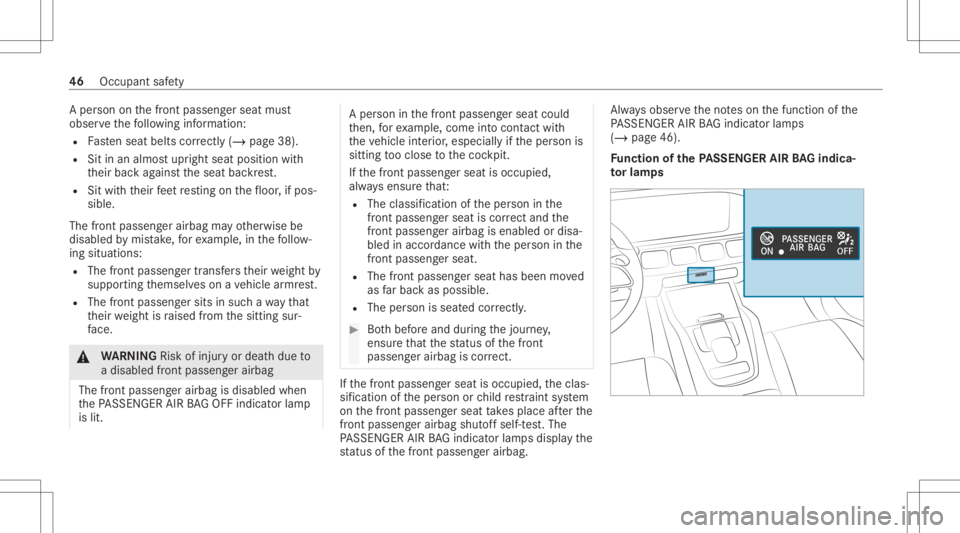
A
pe rson onthefront passeng erseat must
obser vethefo llo wing informatio n:
R Fasten seat belts correctl y(/ page 38).
R Sitinan almos tupr ight seatposi tion with
th eir bac kag ains tth eseat backres t.
R Sitwithth eir feet resting onthefloor ,if pos‐
sible.
The front passeng erairbag mayot her wise be
disabl edbymis take ,fo rex am ple, inthefo llo w‐
ing situat ions:
R The front passen gertr ansf ersth eir weight by
suppor tingthemselv eson ave hicle armr est.
R The front passeng ersits insuc hawa yth at
th eir weight israised from thesitt ing sur‐
fa ce. &
WARNIN GRisk ofinju ryor deat hdue to
a disable dfron tpasse nger airbag
The fron tpasse nger airbag isdisable dwhen
th ePA SSENGER AIRBAGOF Find icat orlam p
is lit. A
per son inthefront passeng erseat could
th en, forex am ple, com eint ocon tact with
th eve hicle interior ,especially ifth eper son is
sitt ing tooclose tothecoc kpit.
If th efront passeng erseat isoccupied,
alw aysensur eth at:
R The classificat ion oftheper son inthe
fr ont passeng ersea tis cor rect and the
fr ont passeng erairb agisenabl edordisa ‐
ble din accor dance withth eper son inthe
fr ont passeng ersea t.
R The front passeng ersea thas been moved
as farbac kas possi ble.
R The person isseat edcor rectl y. #
Both bef oreand during thejour ney,
ensur eth at thest atus ofthefront
passeng erairbag iscor rect. If
th efront passeng erseat isoccupied, theclas‐
sif ication oftheper son orchild restra int system
on thefront passeng erseat take splace afte rth e
fr ont passeng erairb agshut offself-t est.The
PA SSENGER AIRBAGind icat orlam psdispla yth e
st atus ofthefront passeng erairbag. Alw
aysobser vetheno teson thefunc tion ofthe
PA SSENGER AIRBAGind icat orlam ps
(/ page46).
Fu nction ofthePA SSEN GERAIRBAGindic a‐
to rlam ps 46
Occupant safety
Page 50 of 490
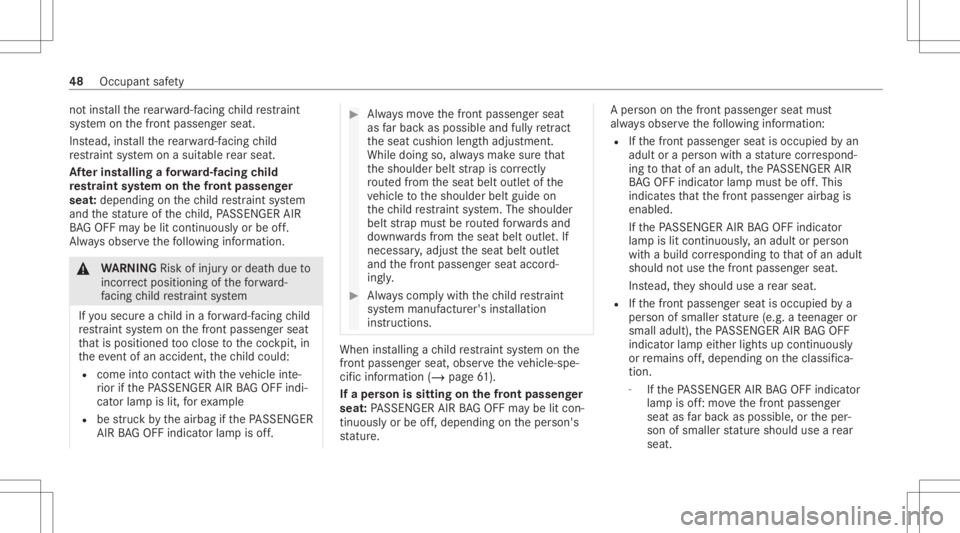
no
tins tallth ere ar wa rd-faci ng child restra int
sy stem onthefront passeng erseat.
Ins tead, installth ere ar wa rd-faci ng child
re stra int system onasuit able rear seat .
Af terin st alli ng afo rw ard-f acin gch ild
re stra int system onthefront passeng er
seat :depen dingonthech ild restra int system
and thest atur eof thech ild, PASSENGER AIR
BA GOF Fma ybe litcon tinuousl yor be off.
Alw aysobser vethefo llo wing informatio n. &
WARNIN GRisk ofinju ryor deat hdue to
inc orrect pos itioning ofthefo rw ard-
fa cing child restra int system
If yo usec ureach ild inafo rw ard-f acin gch ild
re stra int system onthefront passeng erseat
th at isposit ioned tooclose tothecoc kpit, in
th eev ent ofan acciden t,th ech ild could:
R com eint ocon tact with theve hicle inte‐
ri or ifth ePA SSENGER AIRBAGOF Find i‐
cat orlam pis lit,fo rex am ple
R bestru ck bytheairbag ifth ePA SSENGER
AIR BAGOF Find icat orlam pis off. #
Alw aysmo vethefront passeng erseat
as farbac kas possi bleand fully retract
th eseat cushion lengthadjus tment.
While doing so,alwaysmak esur eth at
th eshoulder beltstra pis cor rectl y
ro uted from theseat beltoutle tof the
ve hicle totheshoulder beltguide on
th ech ild restra int system. Theshoulder
belt stra pmus tbe routed forw ards and
do wn wardsfrom theseat beltoutle t.If
neces sary,adjus tth eseat beltoutle t
and thefront passeng erseat accor d‐
ing ly. #
Alw ayscom plywit hth ech ild restra int
sy stem manuf acturer'sinstallation
ins truct ions . When
installing ach ild restra int system onthe
fr ont passeng ersea t,obse rveth eve hicle-spe‐
cif icinf ormation (/page61 ).
If aper son issit tin gon thefront passeng er
seat :PA SSENGER AIRBAGOF Fma ybe litcon ‐
tin uousl yor be off,depen dingon theper son's
st atur e. A
per son onthefront passeng erseat must
alw aysobser vethefo llo wing informatio n:
R Ifth efront passeng erseat isoccupied byan
adult oraper son withast atur ecor respond‐
ing tothat ofan adult ,th ePA SSENGER AIR
BA GOF Find icat orlam pmus tbe off.This
ind icat esthat thefront passeng erairbag is
enabled.
If th ePA SSENGER AIRBAGOF Find icat or
lam pis lit con tinuousl y,an adult orper son
wit habuild corresponding tothat ofan adult
shoul dno tuse thefront passeng erseat.
Ins tead, they should useare ar seat .
R Ifth efront passeng erseat isoccupied bya
per son ofsmaller statur e(e. g.ate enag eror
small adult), thePA SSENGER AIRBAGOF F
ind icat orlam peit her light sup con tinuousl y
or remains off,depe nding ontheclassif ica‐
tion .
- Ifth ePA SSENGER AIRBAGOF Find icat or
lam pis off:mo vethefront passeng er
seat asfarbac kas possi ble,ortheper‐
son ofsmaller statur eshoul duse are ar
seat . 48
Occupan tsaf ety
Page 51 of 490
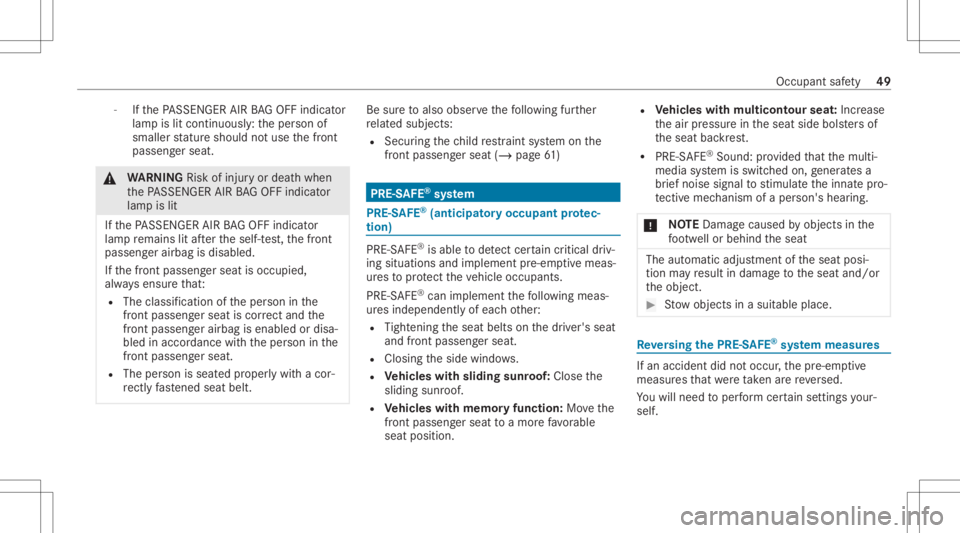
-
Ifth ePA SSENGER AIRBAGOF Find icat or
lam pis lit con tinuousl y:theper son of
smaller statur eshoul dno tuse thefront
passeng erseat. &
WARNIN GRisk ofinju ryor deat hwhen
th ePA SSENGER AIRBAGOF Find icat or
lam pis lit
If th ePA SSENGER AIRBAGOF Find icat or
lam pre mains litafte rth eself-t est,th efront
passeng erairbag isdisabled.
If th efront passeng erseat isoccupied,
alw aysensur eth at:
R The classificat ion oftheper son inthe
fr ont passeng ersea tis cor rect and the
fr ont passeng erairb agisenabl edordisa ‐
ble din accor dance withth eper son inthe
fr ont passeng ersea t.
R The person issea tedpr oper lywit hacor ‐
re ctly fastened seatbelt. Be
sureto also obse rveth efo llo wing further
re lat ed subje cts:
R Sec uring thech ild restra int system onthe
fr ont passeng ersea t(/ page61 ) PRE-S
AFE®
sy stem PRE-
SAFE®
(ant icipa tory occupa ntprotec‐
tion) PRE-
SAFE®
is ab leto detect cer tain critic aldriv‐
ing situat ionsandimplemen tpr e-em ptive meas‐
ur es toprotect theve hicle occupants.
PRE-S AFE®
can implement thefo llo wing meas‐
ur es indepe ndently of eac hot her :
R Tight ening theseat belts onthedr iver's seat
and front passeng erseat.
R Closing theside windo ws.
R Vehicl eswith sliding sunroof:Clo sethe
sliding sunroof.
R Vehicl eswith memor yfuncti on:Movethe
fr ont passeng ersea tto amor efa vo rable
seat position . R
Vehicl eswith multico ntour seat :Incr ease
th eair pressur ein theseat sidebolsters of
th eseat backres t.
R PRE-S AFE®
Sound: prov ided that themulti‐
media system isswitc hedon,gener ates a
br iefnoi sesigna lto stimulat eth einnat epr o‐
te ctiv emec hanism ofaper son's hearing.
* NO
TEDama gecau sed byobject sin the
fo ot we llor behin dth eseat The
automatic adjustmentof theseat posi‐
tion mayre sult indamag eto theseat and/or
th eobjec t. #
Stow object sin asuit able place. Re
versing thePRE- SAFE®
sy stem mea sures If
an acc iden tdid notocc ur,th epr e-em ptive
measur esthat we retak en arere ve rsed.
Yo uwill need toper form certain settings your‐
self . Oc
cupan tsaf ety 49
Page 52 of 490

#
Ifth eseat beltpre-t ension ingisno tre duced,
mo vetheseat backres tbac kslightl y.
The locking mechanism releases. Fu
nction ofPRE-S AFE®
PL US (anticipat ory
occupant protection plus) PRE-
SAFE®
PL US can detect cer tain im pact s,
par ticular lyan imm inentrear impact ,and take
pr e-em ptive measur estoprotect theve hicle
occupants. Thesemeasur escanno tnecessar ily
pr eve ntan imm inentimpact.
PR E-S AFE ®
PL US can implem entthefo llo wing
measur esindepe ndently of eac hot her :
R Tight ening theseat belts onthedr iver's seat
and front passeng erseat.
R Increasin gbr ak epr essur ewhen theve hicle
is statio nary.This brak eapplication iscan‐
celed automaticall ywhen theve hicle pulls
aw ay.
If an accident didnotoccur ,th epr e-em ptive
measur esthat we retake nar ere ve rsed. Sy
stem limit s
The system will notinitiat ean yaction inthefo l‐
lo wing situat ions:
R when backingup
or
R when theve hicle istowing atrailer andther e
is arisk ofare ar impact
The system will notinitiat ean ybr aking applica‐
tion inthefo llo wing situat ions:
R whils tdr ivin g
or
R when entering orexitin gapar kingspace
while using ActivePa rking Assist Fu
nction ofPRE-S AFE®
Im pulse Side If
an imminen tside impact isde tected, PRE-
SA FE®
Im pulse Side canpre-emp tively movethe
fr ont seatve hicle occupant's upperbody
to wa rdsth ecent eroftheve hicle. Itdoes this by
ra pidly inflating anair cushion intheout erseat
side bolsterof theseat backres ton theside on
whic hth eim pact isantic ipated.This increases th
edis tance betwee nth edoor andtheve hicle
occupant.
If PRE-S AFE®
Im pulse Sidehasbeen deployedor
is faulty ,th ePRE-S AFEImpulse SideInoper ative
See Operator 'sManual displaymessag eappear s
(/ page388). Au
tomatic measures afte ran acciden t
Dep endingonthetype andseverity of theacci‐
dent ,and depending ontheve hicle's equipment,
th efo llo wing measur escan beimplemen ted, for
ex am ple:
R Automatic braking (post-collisi onbrak e)
R Activati ng thehazar dwa rning light s
R Trigg ering anaut omat icemer gency call
(/ page 290)
R Switc hingoffth eengine
To restar tth eve hicle, switchth eignition off
and switc hit bac kon (/ page15 1).
Dep endingonthetype andseverity of the
acc iden t,itis poss iblethat theve hicle can
no long erbe star ted. 50
Occupant safety
Page 53 of 490

R
Swi tching offth efuel supply
R Unloc kin gth eve hicle doors
R Lowe ring theside windo ws
R Display ing theemer gency guide in themulti‐
media system displa y
R Switc hingontheint erior lighting
Fu nction ofthepos t-collision brak e
Dep endingontheacciden tsituation ,th epos t-
collision brak ecan minimiz eth ese verity of afu r‐
th er collision oreve navo idit.
If an acc ident isde tected, thepos t-collision
br ak ecan implement automatic braking. When
th eve hicle hascome toast ands till,th eelectr ic
par king brak eis aut omaticall yapplied.
The driver can canc elaut omatic braking bytak‐
ing thefo llo wing actions :
R Brakin gmor est ro ng lythan aut omat icbrak‐
ing
R Fully depr essin gth eaccelera torpeda lwit h
fo rc e Saf
elytranspor tingchildr enintheve hicl e Alw
aysobser vewhen childr enaretrave ling
in theve hicl e %
Also strictly observe thesaf etyno tesfo rth e
specif icsituation. Inthis wa yyo ucan recog‐
nize potentia lri sk sand avoiddang ersif ch il‐
dr en aretrav eling intheve hicle
(/ page52).
Be dilig ent
Bear inmind that neg ligenc ewhen securing the
ch ild inthech ild restra int system mayha ve ser i‐
ous conseq uences. Alwaysbe dilig entinsecur‐
ing ach ild car efull ybef oreeve ryjou rney .
To improve protect ion forch ildr enyoung erthan
tw elv eye arsold orunde r5 ft (1.50 m)inheight ,
Mer cedes- Benzre comme ndsyouobse rveth e
fo llo wing informatio n:
R Alw ayssecur eth ech ild inach ild restra int
sy stem suitable forth is Mer cedes -Benz vehi‐
cle.
R The child restra int system mus tbe appr opri‐
at eto theag e, we ight andsize ofthech ild. R
The vehicle seatmustbe suit able forins tal‐
ling ach ild restra int system.
Ac cid ent statis ticssho wthat childr ensecur ed
on there ar seat sar ege ner ally saf erthan chil‐
dr en secur edon thefront seats. Forth is reason ,
Mer cedes-Ben zst ro ng lyadvis esthat youins tall
a ch ild restra int system onare ar seat .
Th ege ner icterm child restra int system
The gener icterm child restra int system isused
in this Opera tor's Manua l.A ch ild restra int sys‐
te m is, forex am ple:
R abab ycar seat
R are ar wa rd-faci ng child seat
R afo rw ard-f acin gch ild seat
R ach ild boos terseat withabac kres tand seat
belt guide
Mer cedes-Benz recomme ndsusing ach ild
boos terseat withabac kres t.
The child restra int system mus tbe appr opriate
to theag e, we ight andsize ofthech ild. Occ
upant safety 51
Page 54 of 490
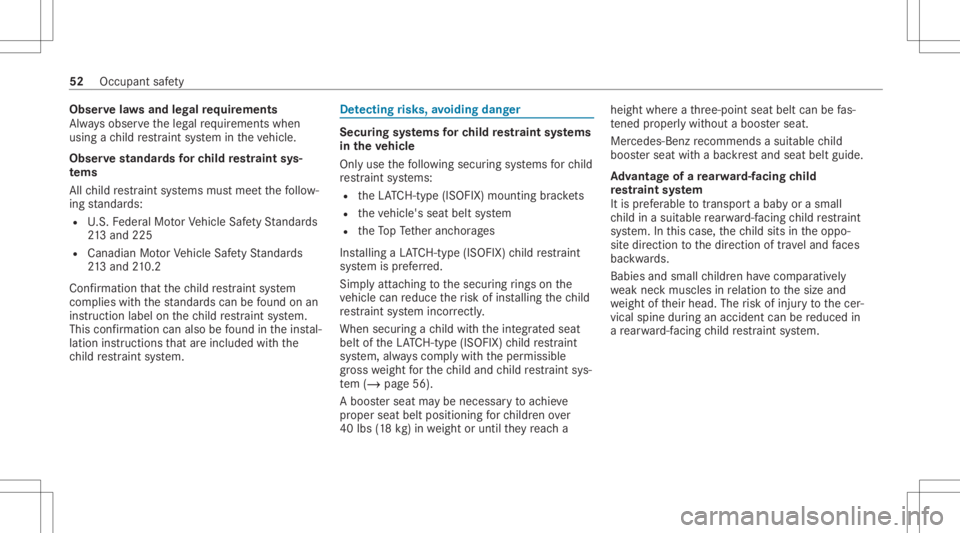
Obser
velaws and legalrequ irement s
Alw aysobser vetheleg alrequ iremen tswhen
using ach ild restra int system intheve hicle.
Obser vestandar dsforch ild restra int sys‐
te ms
All child restra int systems mustmee tth efo llo w‐
ing standar ds:
R U.S. Feder alMo torVe hicle SafetySt andar ds
21 3and 225
R Canadi anMo torVe hicle SafetySt andar ds
21 3and 210.2
Conf irmatio nth at thech ild restra int system
com plies withth est andar dscan befound onan
ins truct ion label onthech ild restra int system.
This confirm atio ncan also befound intheins tal‐
lation instruct ions that areinc luded withth e
ch ild restra int system. De
tectin grisk s,avo iding danger Secur
ingsystems forch ild restra int systems
in theve hicl e
Only usethefo llo wing secur ingsystems forch ild
re stra int systems:
R theLA TC H-type (ISOFIX )mou nting brac kets
R theve hicle's seatbeltsystem
R theTo pTe ther anc horages
Ins talling aLA TC H-type (ISOFIX )ch ild restra int
sy stem isprefer red.
Sim plyattaching tothesecur ingrings onthe
ve hicle canreduce therisk ofins talling thech ild
re stra int system incor rectly .
Whe nsecu ring ach ild withth eint egr ated seat
belt oftheLA TC H-type (ISOFIX )ch ild restra int
sy stem, alwayscom plywit hth eper missible
gr oss weight forth ech ild and child restra int sys‐
te m (/ page56).
A boos terseat maybe necessar yto achie ve
pr oper seatbeltposition ingforch ildr enove r
40 lbs (18 kg )in we ight orunt ilth ey reac ha heigh
twher eath re e-point seatbeltcanbefas‐
te ned prop erly wit hout aboos terseat.
Mer cedes-Benz recomme ndsasu itab lech ild
boos terseat withabac kres tand seat beltguide.
Ad vantag eof are ar wa rd-faci ng child
re stra int system
It is prefer able totrans portabab yor asmall
ch ild inasuit able rear wa rd-faci ng child restra int
sy stem. Inthis case, thech ild sits intheoppo‐
sit edir ect ion tothedir ect ion oftrave land faces
ba ckwa rds.
Babies andsmall childr enhave com parativ ely
we ak nec kmusc lesinrelation tothesize and
we ight oftheir head. Therisk ofinjur yto thecer‐
vical spine during anacciden tcan bereduced in
a re ar wa rd-faci ng child restra int system. 52
Occupant safety